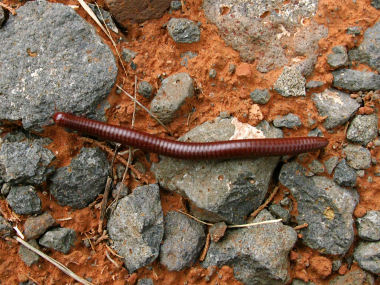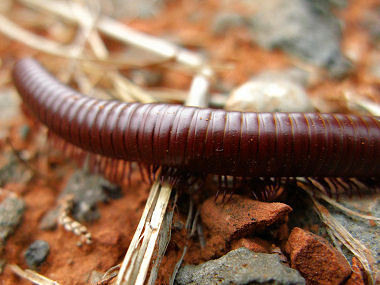|
Millipedes are arthropods with long, cylindrical bodies with 2
pairs of legs on each segment.
 New
segments and pairs of legs are added each time the millipede sheds. Since it
continues to grow and shed throughout its lifetime, itís impossible to say how
many legs a millipede has without counting (but you can be sure there are far
less than 1000). The common millipede in southern Arizona is a dark reddish
brown, and grow to 4 - 5 inches long. New
segments and pairs of legs are added each time the millipede sheds. Since it
continues to grow and shed throughout its lifetime, itís impossible to say how
many legs a millipede has without counting (but you can be sure there are far
less than 1000). The common millipede in southern Arizona is a dark reddish
brown, and grow to 4 - 5 inches long.
|
The Desert Millipede is also known as the Rainworm. |
Millipedes are detritivores, foraging for decaying organic
material (in the desert, generally in sandy washes). They are nocturnal and
prefer humid environments, often appearing on roads after soaking summer
thunderstorms. They are good burrowers and spend most of their time
underground. If disturbed, the millipede rolls into a coil. If further
threatened, it exudes foul-tasting chemicals from openings along the sides of
its body. These noxious substances are the millipedeís only defense, since it
doesnít bite. Millipedes are egg layers that do not care for their eggs or
young. The eggs are laid underground or in some other concealed area.
Millipedes can live 10 years or more.
 |

